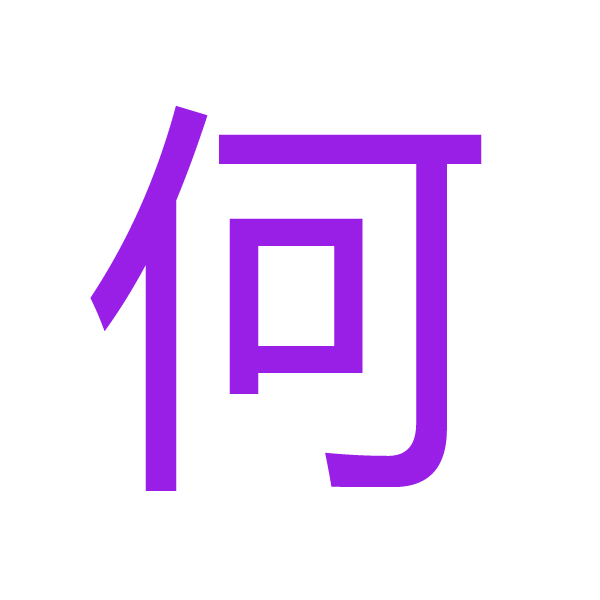
1. Meaning and Usage
The core meaning of the kanji 何 is "what." It is the primary interrogative pronoun used to ask questions about things, actions, or reasons. It can also mean "how many" or "how much" in specific contexts.
Common Readings and Words:
なに (nani): The standard reading for "what."
何ですか (nan desu ka): What is it?
何か (nanika): Something.
何も (nanimo): Nothing (with negative verb).
なん (nan): Used before words that connect easily phonetically, like before です (desu) or counters.
何人 (nan-nin): How many people?
何時 (nan-ji): What time?
何年 (nan-nen): What year?
2. Correct Stroke Order
Writing 何 correctly is straightforward. The kanji is composed of the left radical イ (person) and the right component 可 (can/possible).
Total Strokes: 7
Step-by-Step Breakdown:
Left Radical: イ (Ninben - Person)
Stroke 1: The short left-falling stroke (撇).
Stroke 2: The vertical stroke (竖), starting slightly below the first stroke.
Right Component: 可 (Ka)
Stroke 3: The long horizontal stroke (横), starting from the left radical and extending to the right.
Stroke 4: The vertical stroke (竖) that starts from the center of the horizontal and goes down, hooking slightly to the left at the end.
Stroke 5: The short horizontal stroke inside the "mouth" component.
Stroke 6: The left vertical of the "mouth."
Stroke 7: The final stroke that forms the top and right side of the "mouth" (a single L-shaped stroke).
Key Stroke Order Rules Applied:
Left to Right: Complete the left radical イ before starting the right component 可.
Top to Bottom: This rule governs the order within the 可 component.
Horizontal before Vertical: The long horizontal (Stroke 3) is written before the vertical that crosses it (Stroke 4).
3. Historical Origins and Etymology (The "Story" Behind the Kanji)
The history of 何 is a great example of a 形声文字 (keisei moji) or phonetic-ideographic compound, where the original meaning has shifted significantly over time.
Let's break down its components:
Semantic Component (Original Meaning): 人 (Hito - Person)
The left side is the "person" radical イ. This indicates that the character's original meaning was related to human activity.
Phonetic Component (Sound): 可 (Ka)
This component provided the ancient Chinese pronunciation. The character 可 itself means "can" or "possible," but in 何, its primary role was phonetic.
The Evolution of Meaning:
The original meaning of 何 was not "what," but "to carry a load on one's shoulder." This is perfectly logical when you look at its composition:
A person (イ) is carrying a heavy tool or weapon (which the 可 component may have pictographically represented) on their shoulder.
So, how did a character for "carrying a load" become the word for "what"?
This is a classic case of "loan usage" (仮借 kasha). The character was "borrowed" to represent a word that had the same or similar sound but a different meaning.
The word for "what" in Old Chinese sounded similar to the word for "to carry."
The original, more complex character for "to carry" (何) was borrowed to write the very common and useful word "what."
Over time, this borrowed meaning became the primary one, and the original meaning of "to carry" became obsolete and was replaced by other characters like 荷 (ni), which also uses 何 as its phonetic component and means "load" or "luggage."
4. Example Sentences
Here are some example sentences showing the different uses of 何.
As "What" (なに):
Romaji: Sore wa nan desu ka?
English: What is that?
それは何ですか。
As "What" before a counter (なん):
Romaji: Kaigi wa nan-ji kara hajimarimasu ka?
English: What time does the meeting start?
会議は何時から始まりますか。
In a General Question:
Romaji: Nani o kangaete iru no?
English: What are you thinking about?
何を考えているの?
Summary
Meaning: What.
Writing: 7 strokes. Write the left "person" radical イ first, then the right component 可, ensuring the long horizontal stroke connects from the left.
Origin: A phonetic-ideographic compound. It originally meant "to carry a load on one's shoulder," depicted by a person (イ) with a tool. It was later borrowed for its sound to represent the interrogative pronoun "what," and this borrowed meaning completely superseded the original one. The original meaning is preserved in the kanji 荷 (load/luggage).